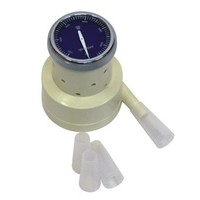Spirometer
A spirometer is an apparatus for measuring the volume of air inspired and expired by the lungs.
This category is empty! Please try another category or use our search function to find what you are looking for. If you require further assistance please contact us.
The Spirometer Explained! Learn More About the Personal and Professional Use of This Device!
Spirometers are just as common as blood pressure monitors in a medical environment. These devices are required to execute spirometry testing, which can tell a medical professional more about your lung function and lung condition. To learn more about this device and its use in medical environments, please read the information provided by Mentone Educational below.
What Is a Spirometer?
A spirometer measures ventilation, which is the movement of air into and out of the lungs. The reading obtained after spirometry testing gives clinicians better insight into the lung function and lung condition of the patient in question. Therefore, this device is often used for the detection of lung diseases and to monitor the asthma within diagnosed patients.
How Does a Spirometer Work?
During spirometry testing, which can take place at your doctor’s office or the hospital, you will be required to take a deep breath in and then breathe out as strongly as you can inside the spirometer. Then, the spirometer will show how much air you breathe in and out, as well as the speed of the breath.
Spirometry testing is used for the detection of various lung diseases; this includes restrictive lung disease, asthma, and other conditions that could affect lung function and lung condition. Spirometry testing is also necessary for asthma management, since this test can help to determine if asthma medication must be increased or decreased for a certain patient.
How Long Are You Required to Use a Spirometer After Surgery?
Some patients use an incentive spirometer post-surgery; this is a device designed to keep the lungs clean and active throughout the recovery process. Even though this type of spirometer is optional, it can prove beneficial for patients who experienced problems with their lung function in the past, or those who often encounter shortness of breath.
To determine if using a spirometer post-surgery could be beneficial for you, always consult your GP. Your physician can instruct you on how to use an incentive spirometer, but also determine if this device could be beneficial for you post-surgery.
The spirometer is not only used after surgery though, it is also a common tool for the detection of various lung diseases. Some patients experience shortness of breath, but a GP cannot determine the cause immediately. So, in some cases, patients will use a spirometer to determine their lung function outside of the GP’s office and then take the results to their physician.
What Is a Good Spirometer Reading?
Spirometers measure lung function in so-called FVC and FEV1 measurements. The FVC value is the greatest total amount of air that can be forcefully breathed out after breathing in as deeply as possible. The FEV1 measurement is the forced expiratory volume, the amount of air that can be expelled in one second.
When the FVC measurement is lower than the standard, it could point to a reduced lung function, poor lung condition, or could be an indicator for various lung diseases. So, to eliminate or detect lung diseases in patients, the spirometer is often the starting point.
To get a normal reading on the FEV1 measurement, adults must get a reading of 80% or greater. If that value is lower than 35%, there is a severe abnormality and medical intervention will be required immediately.
FEV1 and FVC measurements are often examined separately to determine lung condition. However, if a patient suffers from shortness of breath, or is believed to suffer from an underlying lung problem, doctors can analyse the FEV1 – FVC ratio too.
How to Calculate Breathing Rate from a Spirometer?
When a patient suffers from shortness of breath, or another lung-related issue, physicians can look at the breathing rate; this is calculated by using the spirometer trace.
A person’s whole breath is considered the time between an inbreath and an outbreath; indicated by 0 to C. For the purpose of this example, let us take a patient with a whole breath from 0 to C in 5 seconds. To calculate the breathing rate here, you would have to divided 60 seconds by the results obtained through the spirometer. In this case, 60 divided by 5. The result obtained is the patient’s breathing rate.
How to Measure Lung Capacity with a Spirometer?
When a patient experiences shortness of breath, physicians can also look at a patient’s lung capacity. A patient’s lung capacity can be measured with a spirometer too; this since the device measures airflow.
To determine your lung capacity, a physician will ask you to take a deep breath before exhaling into the spirometer. Once you have taken a deep breath, you will be required to exhale as forcefully and quickly as possible into the spirometer; this will provide your physician with an indication of your lung capacity.
Taking a deep breath and getting a normal reading through an exhale can be difficult for patients with diminished lung capacity. Even though a deep breath and strong exhale may seem like a simple test, it can be extremely effective to determine the function and overall capacity of your lungs.
Do you have an interest in spirometry? Or do you work in a field where you often encounter patients with diminished lung capacity and lung problems? If so, be sure to check out the Thoracic Society in Australia, a main hub for all information on the prevention, curing, and relief of lung diseases.
The Australian Thoracic Society is created to provide support to health workers and researchers who often encounter lung disease in their field. With the help of the Thoracic Society, members can gain important knowledge on new developments and treatments, but also find support from the industry’s leading thoracic experts. Being informed as a healthcare professional is what makes a good healthcare professional, so joining the Australian Thoracic Society can be the first step to improving your overall status in the medical world. Check out the Thoracic Society and benefit from their many resources.



















